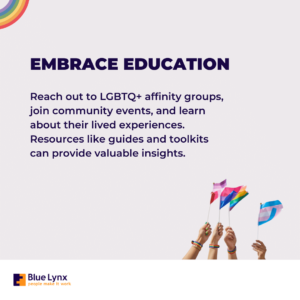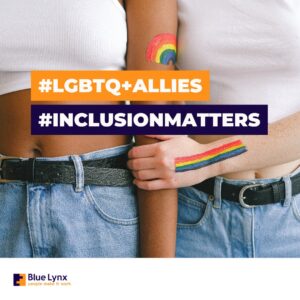Leadership in Action: Empowering LGBTQ+ Colleagues through Allyship

In today’s diverse workplaces, leaders have a crucial role to play in creating a safe and supportive environment for their employees, including members of the LGBTQ+ community.
Did you know that Iran, Northern Nigeria, Saudi Arabia, Somalia and Yemen retain the death penalty for LGBTQ+ people? Furthermore, it still remains a “legal possibility” in Afghanistan, Brunei, Mauritania, Pakistan, Qatar and UAE.
In a study by the American Foundation for Suicide Prevention, members of the LGBTQ+ community were found to be more than twice as likely to attempt suicide compared to heterosexual people. The reasons span from family rejection, bullying and victimisation, discrimination, and lack of legal protection among others.
What is more, LGBTQ+ youth are particularly vulnerable to suicide. The Trevor Project’s National Survey on LGBTQ+ Youth Mental Health reported that LGBTQ+ youth contemplate suicide at almost five times the rate of heterosexual youth.
Being an ally goes beyond a mere label; it requires an ongoing commitment to actively denounce discrimination, embrace education, challenge biases, incorporate diversity metrics, and foster a culture of openness and inclusion. In this article, we will explore how leaders can empower their LGBTQ+ colleagues through allyship, and we will suggest actionable strategies that businesses can adopt.
Understanding Allyship as an Ongoing Process
Being an ally is not a one-time declaration; it is an ongoing journey of actively standing against discrimination and violence. True leadership means operating in solidarity with marginalised groups, including the LGBTQ+ community.
Shocking statistics reveal that 46% of LGBTQ+ workers remain closeted at work and 53% report hearing jokes about gay or lesbian people behind their backs. By openly denouncing such behaviours and creating safe spaces for all, leaders can promote inclusivity and support their LGBTQ+ colleagues.

Helping organisations understand that allyship is an ongoing process is crucial for creating lasting change and fostering an inclusive culture.
Here are some strategies to facilitate this understanding:
- Training and Workshops
Conduct training sessions and workshops that focus on allyship and its continuous nature. Educate employees and leaders about the importance of ongoing commitment, learning, and growth as allies. Provide real-life examples and case studies to illustrate how allyship evolves over time.
- Continuous Education Programs
Establish programs that promote continuous education on diversity, inclusion, and allyship. Offer resources such as articles, videos, webinars, and book clubs that employees can access regularly. Encourage people to stay informed about LGBTQ+ issues, terminology, and evolving best practices.
- Peer-to-Peer Learning
Encourage employees to share their allyship journeys and experiences through internal communication channels. Provide opportunities for open dialogues, panel discussions, or lunch-and-learn sessions where peers can learn from each other’s perspectives and challenges.
- Supportive Networks
Foster employee resource groups or affinity networks focused on LGBTQ+ inclusion and allyship. These groups can organise events, workshops, and mentoring programs to engage employees and promote ongoing allyship education. Encourage leaders to actively participate and show their support.
- Leadership Modeling
Executives play a crucial role in setting the tone for allyship. Encourage leaders to openly discuss their allyship journeys, challenges, and ongoing growth. When leaders consistently demonstrate their commitment, it sends a powerful message to the entire organisation and encourages others to follow.
- Celebrate Allyship Milestones
Recognise and celebrate employees who exemplify ongoing allyship. Establish recognition programs that highlight individuals’ efforts in supporting LGBTQ+ colleagues and fostering an inclusive environment. Share success stories and best practices to inspire others.
Embracing Education for Empathy and Insight
One of the key aspects of being an effective ally to the LGBTQ+ community is continuously educating oneself to develop empathy and gain insightful perspectives. By actively seeking education, leaders can better understand the challenges faced by LGBTQ+ people and become more effective advocates.
Studies have shown that education about LGBTQ+ issues can significantly impact acceptance levels. The GLSEN National School Climate Survey revealed that schools with comprehensive LGBTQ+ inclusive curricula had lower rates of bullying and higher levels of student well-being and acceptance. Moreover, perspectives through education and media can reduce prejudice and negative attitudes toward the community. This demonstrates the transformative power of education in fostering empathy and understanding.

Developing cultural competence through LGBTQ+ education enables leaders to create a more inclusive work environment. It allows them to navigate diverse identities, understand the unique challenges faced by LGBTQ+ individuals, and implement inclusive policies and practices.
Strategies to Embrace Education:
- Engage with LGBTQ+ Affinity Groups
Organisations often have LGBTQ+ affinity groups or employee resource groups. Leaders can actively participate and engage with these groups to learn about the experiences, needs, and perspectives of LGBTQ+ individuals within their organisation. This direct engagement helps foster empathy and insight.
- Attend LGBTQ+ Community Events
Local LGBTQ+ community events, such as pride parades, panel discussions, and workshops, provide opportunities for leaders to gain firsthand knowledge and connect with the community. These events facilitate meaningful interactions and help broaden perspectives.
- Utilize Available Resources
Numerous educational resources, guides, and toolkits are available to aid allyship. Organisations like the Human Rights Campaign (HRC) and Stonewall offer comprehensive guides for inclusive workplaces. Leaders can utilise these resources to deepen their understanding and promote best practices.
- Training and Workshops
Organise training sessions and workshops specifically focused on LGBTQ+ inclusion and allyship. These sessions can cover topics such as LGBTQ+ terminology, cultural competency, and strategies for creating inclusive environments. Expert facilitators can provide valuable insights and guidance.
- Promote Self-Education
Encourage leaders to take personal responsibility for their education by reading books, articles, and academic research on LGBTQ+ issues. Encourage them to follow LGBTQ+ activists, organisations, and influencers on social media to stay informed about current issues and discussions.
Challenging Unconscious Bias in Hiring
Unconscious biases can inadvertently influence hiring decisions, leading to a lack of diversity and inclusion within organisations. Recognising and challenging these biases is essential for creating equitable opportunities for LGBTQ+ individuals.
Did you know that a study by McKinsey & Company found that companies with diverse leadership teams were more likely to outperform their industry peers in terms of financial performance? Embracing diversity, including LGBTQ+ representation, can bring fresh perspectives, innovative ideas, and improved decision-making to organisations.
Strategies for Challenging Unconscious Bias:
- Structured Hiring Processes
Implement structured hiring processes that evaluate candidates based on their relevant capabilities and qualifications. Standardise interview questions, scoring systems, and evaluation criteria to reduce the impact of subjective biases.
- Diverse Interview Panels
Include diverse representation on interview panels to ensure multiple perspectives are considered. Having LGBTQ+ people involved in hiring can help counteract biases and foster a more inclusive evaluation.
- Training on Unconscious Bias
Provide training to hiring managers and decision-makers to raise awareness about unconscious biases and their impact on the hiring process. Education and training can help people recognise their biases and develop strategies to mitigate them.
- Diverse Candidate Sourcing
Actively seek out diverse candidates by leveraging a range of recruitment channels, networks, and professional associations that cater to LGBTQ+ professionals. Expanding the candidate pool increases the chances of finding talented LGBTQ+ people who can contribute to the organisation’s success.
- Data-Driven Evaluation
Regularly review and analyse hiring data to identify any potential biases or disparities. Use metrics and data points to track the progress of diversity and inclusion initiatives, ensuring that LGBTQ+ candidates receive fair consideration and representation throughout the hiring process.
Fostering a Culture of Openness and Inclusion
Creating a culture of openness and inclusion is crucial for organisations to support their LGBTQ+ colleagues and cultivate a work environment where everyone can thrive.
According to a study published in the Harvard Business Review, teams that fostered a sense of psychological safety, where individuals feel safe to express themselves without fear of negative consequences, performed better and were more innovative. Creating an inclusive culture of openness contributes to this psychological safety, allowing LGBTQ+ individuals to bring their authentic selves to work.

Evidently, companies with diverse and inclusive cultures were more likely to outperform their peers financially. Inclusive workplaces where LGBTQ+ employees feel valued and supported tend to have higher employee engagement, productivity, and innovation, resulting in improved business outcomes.
What is more, Glassdoor found that 67% of job seekers consider diversity and inclusion an important factor when evaluating potential employers. Fostering a culture of openness and inclusion increases the likelihood of attracting and retaining top LGBTQ+ talent, as individuals seek workplaces where they can feel accepted and valued.
Strategies for Fostering a Culture of Openness and Inclusion:
- Leadership Commitment
Leaders play a crucial role in shaping the culture of an organisation. It is important for leaders to publicly demonstrate their commitment to LGBTQ+ inclusion and allyship. By vocalising their support, leaders set the tone and encourage others to follow suit.
- Clear Policies and Practices
Establish clear policies and practices that promote inclusion, such as non-discrimination policies and guidelines on gender expression and identity. Communicate these policies effectively and ensure they are consistently enforced throughout the organisation.

- Employee Resource Groups (ERGs)
Support and encourage the formation of LGBTQ+ employee resource groups within the organisation. These groups provide a platform for LGBTQ+ employees to connect, share experiences, and advocate for inclusive policies and practices. Leadership involvement in ERGs demonstrates support and fosters a sense of belonging.
- Regular Communication and Training
Engage in ongoing communication about diversity, inclusion, and LGBTQ+ issues. Conduct regular training sessions and workshops to educate employees about LGBTQ+ experiences, terminology, and best practices for creating an inclusive environment. Encourage open dialogue and address any concerns or questions that arise.
- Inclusive Benefits and Policies
Review and update organisational benefits and policies to ensure they are inclusive of LGBTQ+ individuals. This includes offering benefits like insurance coverage for domestic partners, parental leave for adoptions, and supporting gender-affirming procedures. Inclusive policies demonstrate a commitment to supporting the needs of LGBTQ+ employees.
- Celebrate Diversity and Achievements
Recognise and celebrate diversity by highlighting LGBTQ+ events and milestones. Acknowledge the contributions and achievements of LGBTQ+ employees within the organisation. Celebrations and recognition help create a sense of pride and foster inclusivity.

To sum it up
True leadership lies in taking action to empower, support, and provide psychological safety for LGBTQ+ colleagues. It requires an ongoing commitment to denouncing discrimination, embracing education, challenging unconscious bias, incorporating diversity metrics, and fostering a culture of openness and inclusion. By actively exercising allyship, leaders can create a workplace where LGBTQ+ individuals feel supported, valued, and able to bring their whole selves to work. The benefits of such efforts are far-reaching, leading to increased employee engagement, improved business outcomes, and a stronger sense of a supportive community within the organisation. Let us continue to champion LGBTQ+ empowerment and work together to create a more inclusive and equitable future for all.

